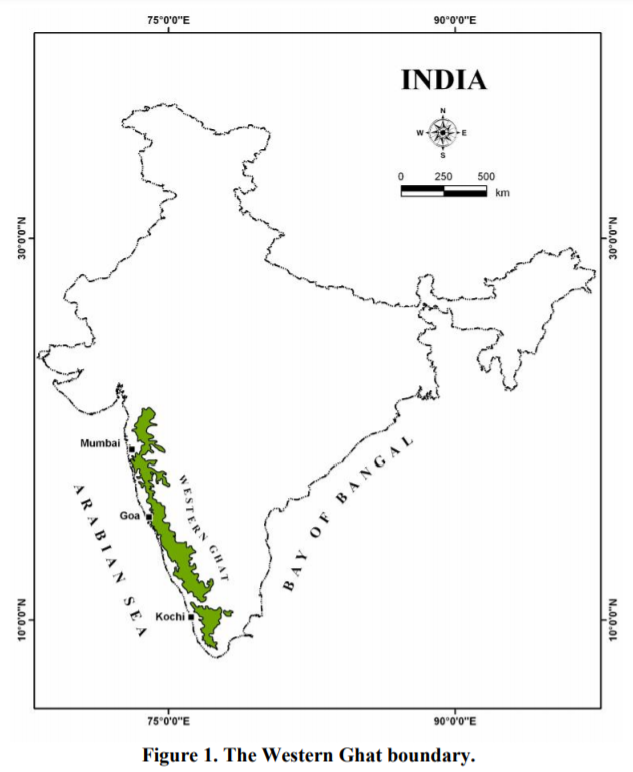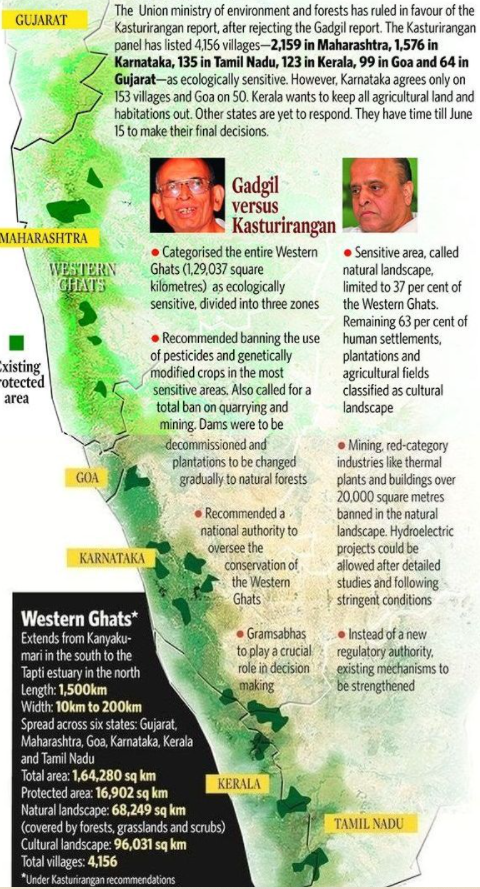Western Ghats
2021 OCT 25
Mains >
Environment & Ecology > Biodiversity > Committees
IN NEWS:
- Flash floods and back-to-back landslips in Kerala bring into focus, once again, the fragile ecosystem of the mountain chain that runs almost parallel to India’s western coast.
WESTERN GHATS:
- The Western Ghats, also known as Sahyadri, is a mountain range that stretches 1,600 kms parallel to the western coast of the Indian peninsula.
- It starts from the mouth of river Tapti in Gujarat and extends to Kanyakumari in Tamilnadu.
- It stretches over the six States of Tamil Nadu, Karnataka, Kerala, Goa, Maharashtra and Gujarat.
- It is a UNESCO World Heritage Site and is one of the eight hot-spots of biological diversity in the world.

SIGNIFICANCE OF WESTERN GHATS:
- Ecosystem services:
- Hydrological: The Western Ghats is the source of many peninsular rivers, including the three major eastward-flowing rivers- Godavari, Krishna, and Kaveri.
- Climatic: The Ghats act as a key barrier to the South-west monsoon winds that blow during late summer. The evergreen forests on the mountains also have a profound influence on the monsoonal winds.
- Ecological: The evergreen forests of Western Ghats play a significant role in the sequestration of carbon dioxide and hence have an important role in addressing climate change.
- Fauna and flora:
- The area is one of the world's "hottest biodiversity hotspots". The 39 serial sites of the Western Ghats were inscribed into UNESCO’s World Heritage Site list in 2012. It hosts 13 national parks and several sanctuaries. It also houses a variety of endemic fauna and flora.
- Eg: 52% tree species and 65% of amphibians found in western Ghats are endemic.
- Resources:
- Abiotic: The ghats has rich deposits of iron, manganese and bauxite. The Kudremukh iron ore mine in Karnataka is an example.
- Biotic: The forests are an important source of spice, timber and non-timber forest products.
- Economic:
- The region houses large plantations of cash crops such as tea, coffee and rubber. It also houses several hydroelectric projects, such as the Idukki Hydroelectric Project and Koyna Hydroelectric Project.
- Cultural:
- The ghats is home to several tribes, such as the Sholanaikers, Irula, Kurumba and Toda.
- The region also houses several tourist destinations such as Ooty and Dandeli and pilgrim centres such as Sabarimala in Kerala and Mahabaleswar in Maharashtra.
THREATS TO WESTERN GHATS:
- Land use change:
- Population growth, agricultural expansion, economic development and infrastructure, particularly road construction, have led to settlement of the highlands.
- Eg: Kerala is experiencing high growth of residential buildings. The Census records that between 2001 and 2011, the population grew by 5% whereas the number of houses grew by 19.9%. The demand for land and construction material are mostly met through the ghats.
- Encroachment:
- Encroachments and diversion of forest land, both legal and illegal, is rampant in the region. This has resulted in pollution, deforestation, frequent man-animal conflicts and landslips along the region.
- Mining and quarrying:
- Iron ore mining has grown rapidly, especially in Karnataka and Goa. Similarly, sand mining and granite quarries have mushroomed in Kerala. Many of them are illegal, often violating the regulations, resulting in serious environmental damage and social disruption.
- Eg: Kerala has 5,924 active stone quarries and crushers, but only 750 have the mandatory official permission from the Mining and Geology Department.
- Extensive monoculture:
- The domination of large plantations of tea, coffee, rubber etc. and heavy use of chemical fertilizers in the Ghats has resulted in soil degradation, erosion and reduction of endemic vegetation.
- Invasive species:
- Many species of flora introduced for cultivation, such as eucalyptus, and wattle (Acacia), have become highly invasive, resulting in the reduction of endemic species.
- Mega projects:
- As demand for energy increases, the states are planning to build more dams. Many of these are located in eco-sensitive parts of the Western Ghats, which in turn could lead to massive deforestation and ecosystem destruction.
- Eg: Despite the Western Ghats Ecology Expert Panel recommendation that no mining and thermal power plants be allowed in Eco Sensitive Zone-1, the Centre in 2019 has granted environmental clearance for capacity expansion of two units of the Kaiga Atomic Power Project.
- Climate change:
- Alterations in the region’s green cover and increased emissions have resulted in variations in the duration and intensity of rainfalls. This is a major reason for the recurrence of major floods and forest fires in the ghats.
ECO SENSITIVE AREAS:
- Ecologically Sensitive Areas (ESA) are those areas that are ecologically and economically very important, but, vulnerable to even mild disturbances and hence demand conservation.
- Ecologically Sensitive Area refers to extensive tracts and Ecologically Sensitive Zone to specific zones within the extended Ecologically Sensitive Area.
- Criteria for identification of an ESA may be Species-based, Ecosystem-based, Geo- morphological features-based.
- Eco-Sensitive Areas (ESAs)are located within 10 kms around Protected Areas, National Parks and Wildlife Sanctuaries.
- They are notified by the Ministry of Environment, Forest and Climate Change (MoEFCC) under Environment Protection Act 1986.
MADHAV GADGIL COMMITTEE REPORT:
The Western Ghats Ecology Expert Panel (WGEEP), popularly known as Gadgil Commission, named after its chairman Madhav Gadgil, was constituted to find a strategy for conserving the Ghats. The commission submitted the report to the Government in August 2011.
Key recommendations:
- It has designated the entire Western Ghats as an Ecologically Sensitive Area (ESA)
- It had classified the 142 taluks in the Western Ghats boundary into three Ecologically Sensitive Zones (ESZs). It assigned three levels of Ecological Sensitivity to different regions, with broad sectoral guidelines for each of these zones:
- Ecologically Sensitive Zone 1 (ESZ1)
- Ecologically Sensitive Zone 2 (ESZ2)
- Ecologically Sensitive Zone 3 (ESZ3)
- A bottom-up approach with grama sabhas and panchayats involved in the decision-making process.
- No new large dams, thermal power stations or hill stations be permitted in ESZ 1.
- No more inter-basin diversions of rivers shall be allowed in the Western Ghats.
- Ban on growing of single commercial crops like tea, coffee, cardamom, rubber, banana, pineapple that are causing widespread soil erosion.
- Promotion of organic farming, traditional agricultural varieties and phasing out pesticides and weedicides.
- Indefinite moratorium on new environmental clearances for mining in ecologically sensitive zones (ESZ I & II) and stronger laws for regulation of sand mining are to be developed.
- A Western Ghats Ecology Authority (WGEA) should be established as a statutory authority to focus on promoting transparency, openness and participation in every way for development and sustainability of these areas.
KASTURIRANGAN COMMITTEE REPORT:
The Gadgil report was rejected by the Union Environment Ministry and the six Western Ghats States citing severe opposition. A year later, the government appointed a 10-member high-level working group (HLWG) under the chairmanship of K Kasturirangan.
Key recommendations:
- Instead of the total area of Western Ghats, only 37% of the Western Ghats region be classified as an ESA.
- Instead of the system of gradation recommended by the Gadgil commission, Rangarajan banked on an existing system of ‘red’, ‘orange’ and ‘green’ categorisation of activities according to their polluting effects.
- ‘Red’ category industries (like mining and quarrying) be banned
- ‘Orange’ ones (like food processing, hotels and restaurants, automobile servicing) be regulated
- ‘Green’ (like processing of grains, apparel-making) be allowed to function as usual.
- A complete ban on mining, quarrying and sand mining in ESA. But existing operations would be allowed to continue until their lease expired but that the lease would not be renewed.
- No thermal power be allowed, but hydropower projects may be allowed only after detailed study.
- Exclusion of inhabited regions and plantations from the purview of ecologically sensitive areas (ESAs).
- A top-down approach involving bureaucrats and forest officials in the decision-making process.

CHALLENGES TO IMPLEMENTATION:
- Public misconception: The reports were not made available for immediate public discussion and were not available in regional languages. This resulted in the spread of misinformation about the reports’ recommendations, creating a negative public perception.
- Vested interests: Since the implementation of the reports affect their activities, mining mafias have been lobbying against the reports. They created fear among the people that the reports were anti-farmer and anti-people.
- Political apathy: The draft notification to finalize the eco-sensitive zones in the Western Ghats has been pending for eight years. This is despite repeated efforts by the National Green Tribunal.
- Involvement of private land: A large part of the proposed ecologically sensitive zones belong to private citizens. Hence, attempts to introduce social control over the use of private land is often being challenged.
- Demand for further reduction: Since the time of submission of the reports,the regions have undergone demographic and infrastructural changes. Hence, the concerned states have been seeking to reduce the notified area to be further reduced.
- Opposition by environmentalists: They argue that while Gadgil report was more environment-friendly, Kasturirangan report was biased towards development. Also, the Kasturirangan panel used remote sensing and aerial survey methods instead of examining the ground reality, which has caused many errors in the report. Hence, they have been demanding the implementation of Gadgil report.
WAY FORWARD:
In the debate between environment and development, it is tough to achieve a perfect balance. However, the recent floods and landslips reported in Kerala and Karnataka is a wake-up call.
Hence, urgent measures must be taken for the protection of Western ghats. The best way to do this is by implementing the recommendations of the Gadgil committee report and developing a stringent land-use protocol.
PRACTICE QUESTION:
Q. Examine the reasons for the recurring landslides in Western Ghats. What measures can be taken address the risk and promote the conservation of Western ghats?

